Strategic Leadership, Corporate Governance, and Firm Success
VerifiedAdded on 2020/12/10
|9
|2917
|126
Essay
AI Summary
This essay delves into the pivotal role of strategic leadership in achieving high firm performance. It examines the functions of top management teams and the significance of corporate governance in directing and controlling organizations. The essay explores the influence of strategic leaders on decision-making, productivity, and the development of a high-performance culture. It highlights the importance of leadership traits, various leadership styles such as autocratic, bureaucratic, democratic, and laissez-faire, and different approaches including situational, transactional, and transformational leadership. The essay also analyzes the roles of key figures like CEOs, chairmen, and general managers in strategic decision-making and their impact on organizational success, using examples like Nestle to illustrate these concepts. Finally, it emphasizes the establishment of parameters by strategic leaders to measure operational efficiency and the application of specific tools for advancement and automation.
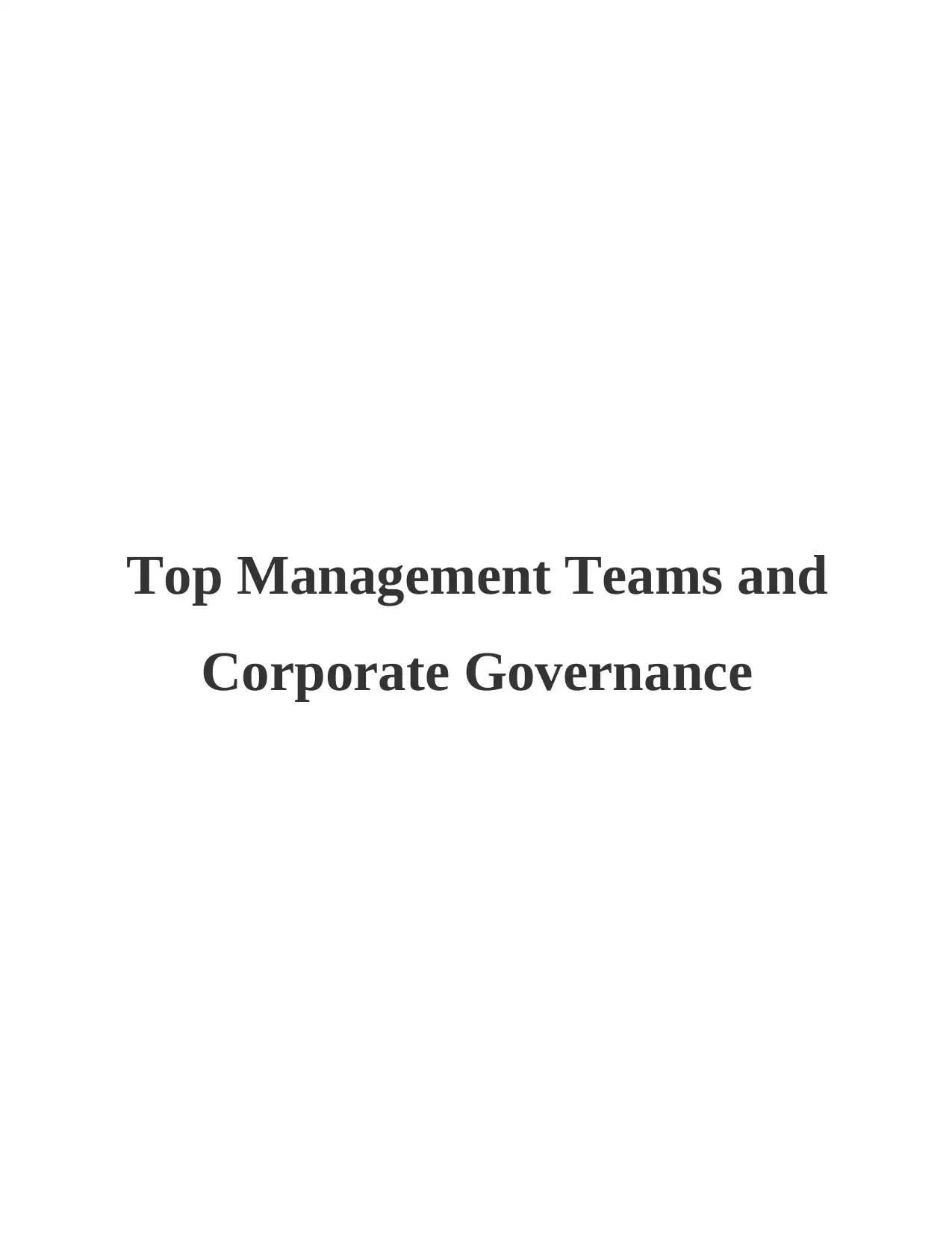
Top Management Teams and
Corporate Governance
Corporate Governance
Paraphrase This Document
Need a fresh take? Get an instant paraphrase of this document with our AI Paraphraser
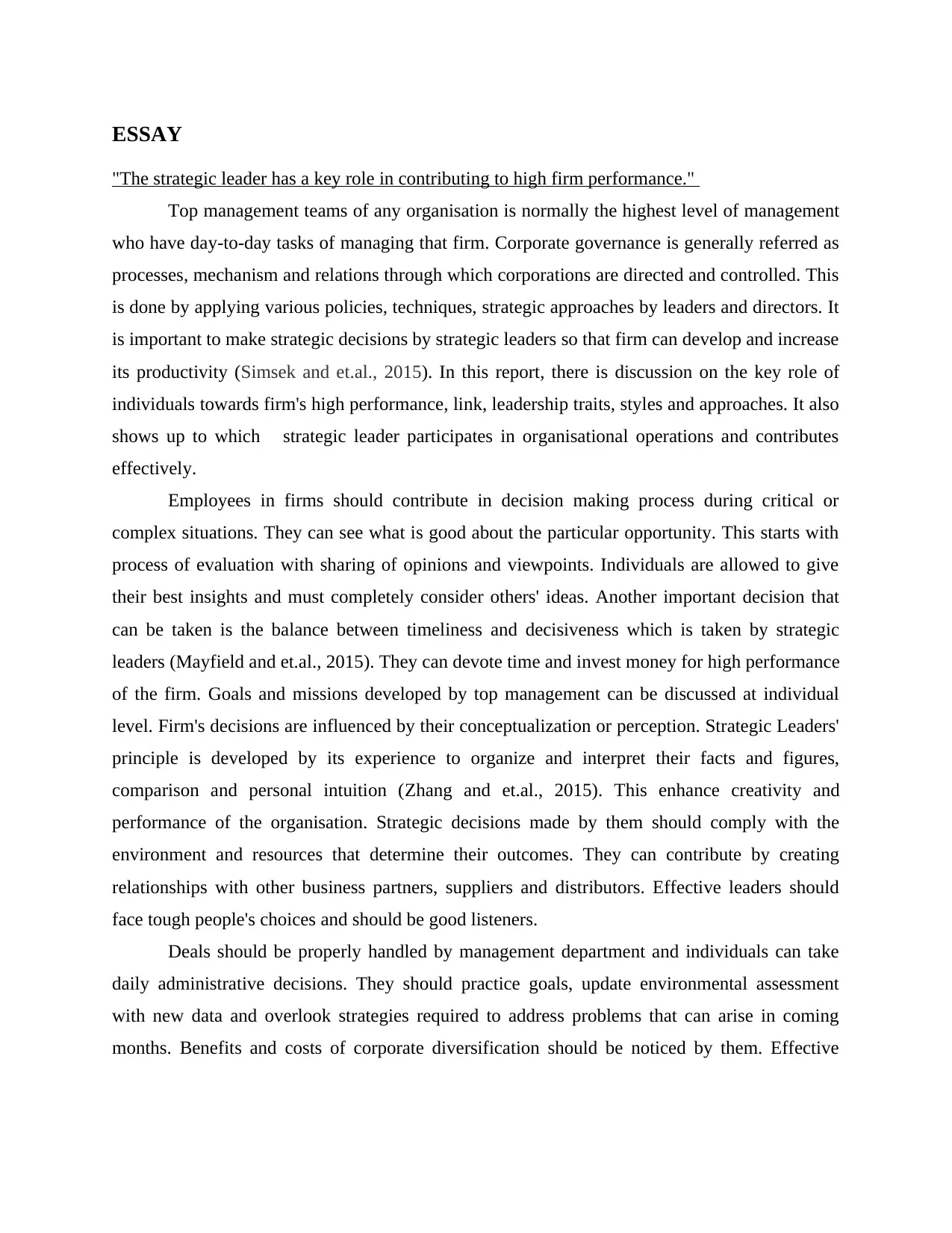
ESSAY
"The strategic leader has a key role in contributing to high firm performance."
Top management teams of any organisation is normally the highest level of management
who have day-to-day tasks of managing that firm. Corporate governance is generally referred as
processes, mechanism and relations through which corporations are directed and controlled. This
is done by applying various policies, techniques, strategic approaches by leaders and directors. It
is important to make strategic decisions by strategic leaders so that firm can develop and increase
its productivity (Simsek and et.al., 2015). In this report, there is discussion on the key role of
individuals towards firm's high performance, link, leadership traits, styles and approaches. It also
shows up to which strategic leader participates in organisational operations and contributes
effectively.
Employees in firms should contribute in decision making process during critical or
complex situations. They can see what is good about the particular opportunity. This starts with
process of evaluation with sharing of opinions and viewpoints. Individuals are allowed to give
their best insights and must completely consider others' ideas. Another important decision that
can be taken is the balance between timeliness and decisiveness which is taken by strategic
leaders (Mayfield and et.al., 2015). They can devote time and invest money for high performance
of the firm. Goals and missions developed by top management can be discussed at individual
level. Firm's decisions are influenced by their conceptualization or perception. Strategic Leaders'
principle is developed by its experience to organize and interpret their facts and figures,
comparison and personal intuition (Zhang and et.al., 2015). This enhance creativity and
performance of the organisation. Strategic decisions made by them should comply with the
environment and resources that determine their outcomes. They can contribute by creating
relationships with other business partners, suppliers and distributors. Effective leaders should
face tough people's choices and should be good listeners.
Deals should be properly handled by management department and individuals can take
daily administrative decisions. They should practice goals, update environmental assessment
with new data and overlook strategies required to address problems that can arise in coming
months. Benefits and costs of corporate diversification should be noticed by them. Effective
"The strategic leader has a key role in contributing to high firm performance."
Top management teams of any organisation is normally the highest level of management
who have day-to-day tasks of managing that firm. Corporate governance is generally referred as
processes, mechanism and relations through which corporations are directed and controlled. This
is done by applying various policies, techniques, strategic approaches by leaders and directors. It
is important to make strategic decisions by strategic leaders so that firm can develop and increase
its productivity (Simsek and et.al., 2015). In this report, there is discussion on the key role of
individuals towards firm's high performance, link, leadership traits, styles and approaches. It also
shows up to which strategic leader participates in organisational operations and contributes
effectively.
Employees in firms should contribute in decision making process during critical or
complex situations. They can see what is good about the particular opportunity. This starts with
process of evaluation with sharing of opinions and viewpoints. Individuals are allowed to give
their best insights and must completely consider others' ideas. Another important decision that
can be taken is the balance between timeliness and decisiveness which is taken by strategic
leaders (Mayfield and et.al., 2015). They can devote time and invest money for high performance
of the firm. Goals and missions developed by top management can be discussed at individual
level. Firm's decisions are influenced by their conceptualization or perception. Strategic Leaders'
principle is developed by its experience to organize and interpret their facts and figures,
comparison and personal intuition (Zhang and et.al., 2015). This enhance creativity and
performance of the organisation. Strategic decisions made by them should comply with the
environment and resources that determine their outcomes. They can contribute by creating
relationships with other business partners, suppliers and distributors. Effective leaders should
face tough people's choices and should be good listeners.
Deals should be properly handled by management department and individuals can take
daily administrative decisions. They should practice goals, update environmental assessment
with new data and overlook strategies required to address problems that can arise in coming
months. Benefits and costs of corporate diversification should be noticed by them. Effective
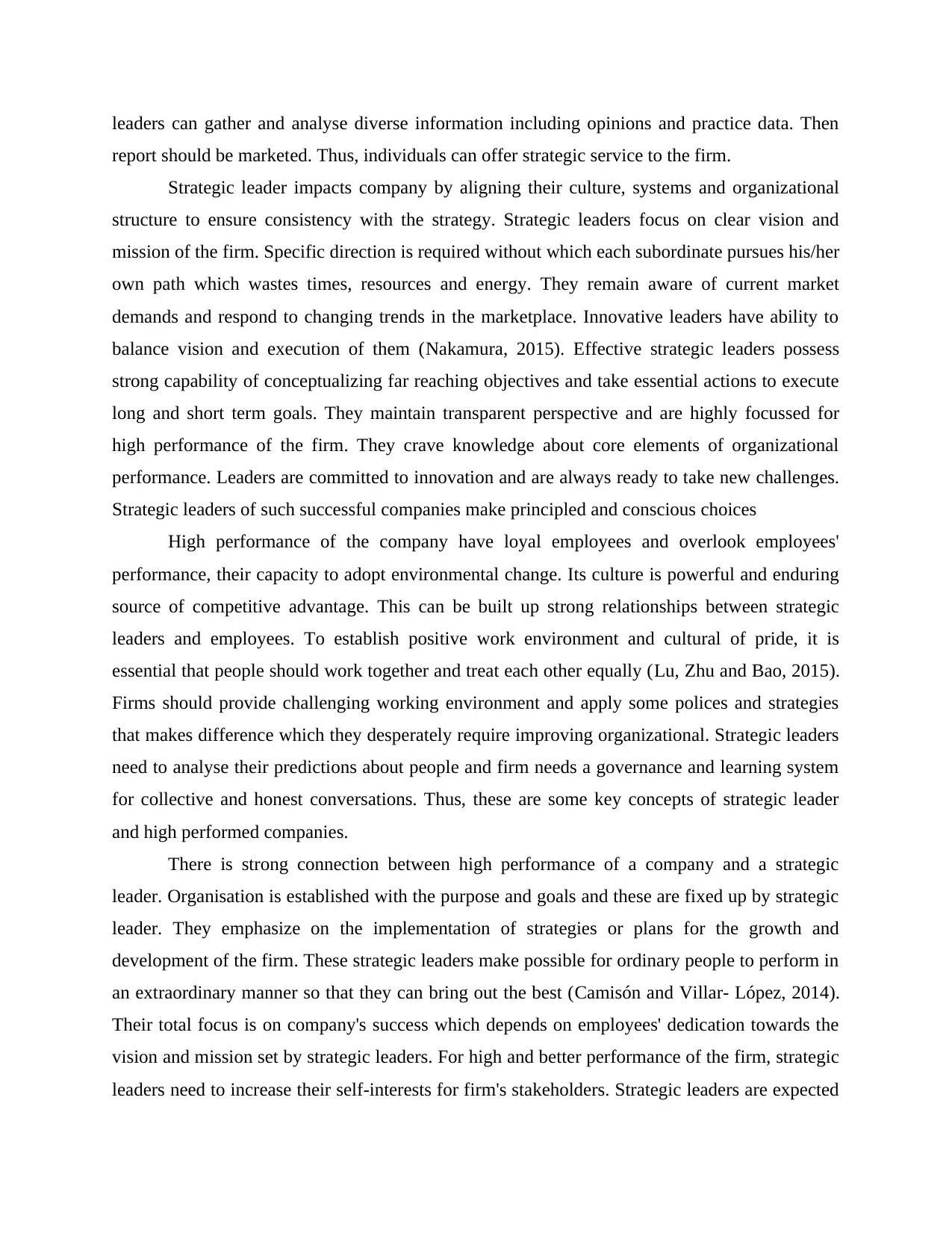
leaders can gather and analyse diverse information including opinions and practice data. Then
report should be marketed. Thus, individuals can offer strategic service to the firm.
Strategic leader impacts company by aligning their culture, systems and organizational
structure to ensure consistency with the strategy. Strategic leaders focus on clear vision and
mission of the firm. Specific direction is required without which each subordinate pursues his/her
own path which wastes times, resources and energy. They remain aware of current market
demands and respond to changing trends in the marketplace. Innovative leaders have ability to
balance vision and execution of them (Nakamura, 2015). Effective strategic leaders possess
strong capability of conceptualizing far reaching objectives and take essential actions to execute
long and short term goals. They maintain transparent perspective and are highly focussed for
high performance of the firm. They crave knowledge about core elements of organizational
performance. Leaders are committed to innovation and are always ready to take new challenges.
Strategic leaders of such successful companies make principled and conscious choices
High performance of the company have loyal employees and overlook employees'
performance, their capacity to adopt environmental change. Its culture is powerful and enduring
source of competitive advantage. This can be built up strong relationships between strategic
leaders and employees. To establish positive work environment and cultural of pride, it is
essential that people should work together and treat each other equally (Lu, Zhu and Bao, 2015).
Firms should provide challenging working environment and apply some polices and strategies
that makes difference which they desperately require improving organizational. Strategic leaders
need to analyse their predictions about people and firm needs a governance and learning system
for collective and honest conversations. Thus, these are some key concepts of strategic leader
and high performed companies.
There is strong connection between high performance of a company and a strategic
leader. Organisation is established with the purpose and goals and these are fixed up by strategic
leader. They emphasize on the implementation of strategies or plans for the growth and
development of the firm. These strategic leaders make possible for ordinary people to perform in
an extraordinary manner so that they can bring out the best (Camisón and Villar- López, 2014).
Their total focus is on company's success which depends on employees' dedication towards the
vision and mission set by strategic leaders. For high and better performance of the firm, strategic
leaders need to increase their self-interests for firm's stakeholders. Strategic leaders are expected
report should be marketed. Thus, individuals can offer strategic service to the firm.
Strategic leader impacts company by aligning their culture, systems and organizational
structure to ensure consistency with the strategy. Strategic leaders focus on clear vision and
mission of the firm. Specific direction is required without which each subordinate pursues his/her
own path which wastes times, resources and energy. They remain aware of current market
demands and respond to changing trends in the marketplace. Innovative leaders have ability to
balance vision and execution of them (Nakamura, 2015). Effective strategic leaders possess
strong capability of conceptualizing far reaching objectives and take essential actions to execute
long and short term goals. They maintain transparent perspective and are highly focussed for
high performance of the firm. They crave knowledge about core elements of organizational
performance. Leaders are committed to innovation and are always ready to take new challenges.
Strategic leaders of such successful companies make principled and conscious choices
High performance of the company have loyal employees and overlook employees'
performance, their capacity to adopt environmental change. Its culture is powerful and enduring
source of competitive advantage. This can be built up strong relationships between strategic
leaders and employees. To establish positive work environment and cultural of pride, it is
essential that people should work together and treat each other equally (Lu, Zhu and Bao, 2015).
Firms should provide challenging working environment and apply some polices and strategies
that makes difference which they desperately require improving organizational. Strategic leaders
need to analyse their predictions about people and firm needs a governance and learning system
for collective and honest conversations. Thus, these are some key concepts of strategic leader
and high performed companies.
There is strong connection between high performance of a company and a strategic
leader. Organisation is established with the purpose and goals and these are fixed up by strategic
leader. They emphasize on the implementation of strategies or plans for the growth and
development of the firm. These strategic leaders make possible for ordinary people to perform in
an extraordinary manner so that they can bring out the best (Camisón and Villar- López, 2014).
Their total focus is on company's success which depends on employees' dedication towards the
vision and mission set by strategic leaders. For high and better performance of the firm, strategic
leaders need to increase their self-interests for firm's stakeholders. Strategic leaders are expected
⊘ This is a preview!⊘
Do you want full access?
Subscribe today to unlock all pages.

Trusted by 1+ million students worldwide
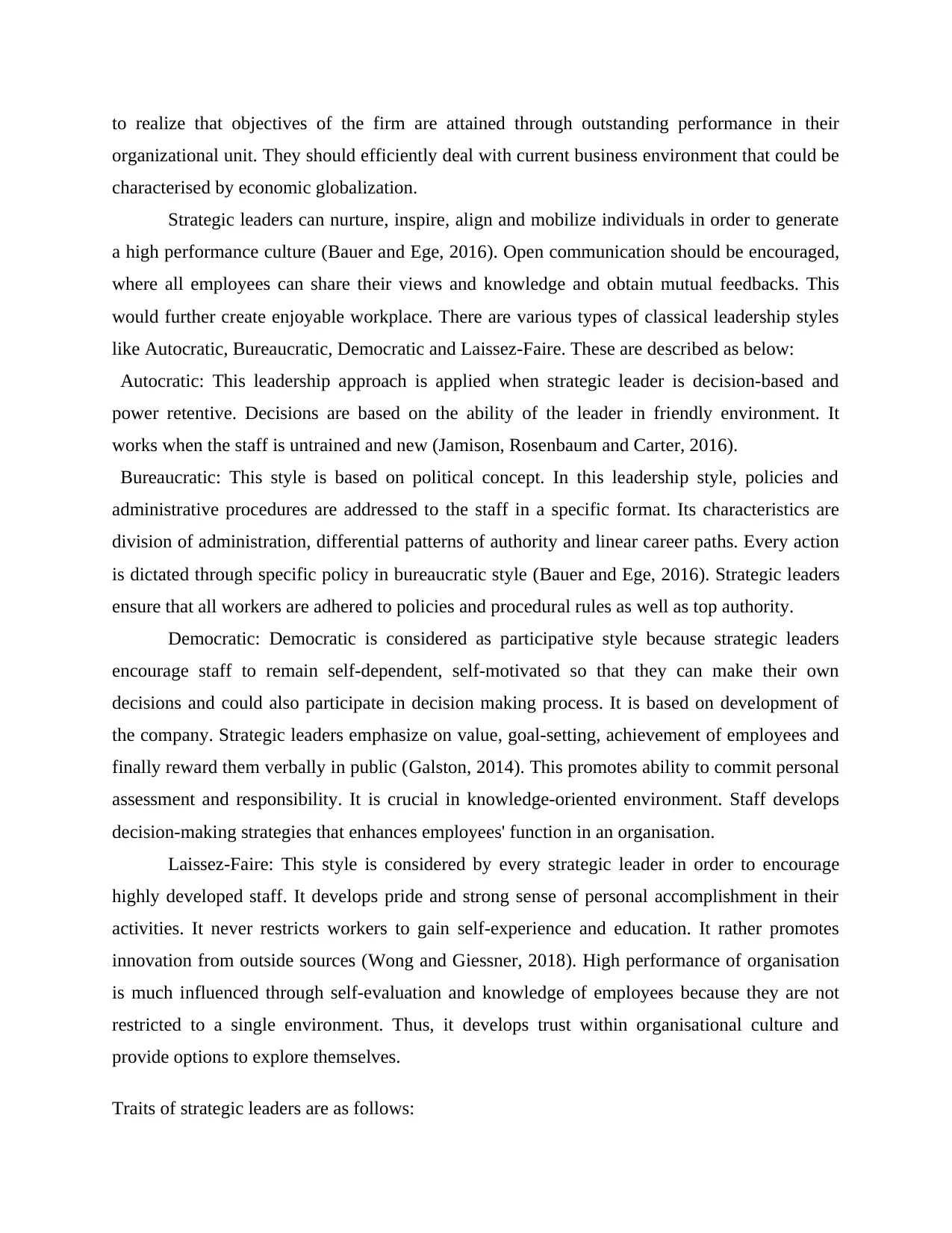
to realize that objectives of the firm are attained through outstanding performance in their
organizational unit. They should efficiently deal with current business environment that could be
characterised by economic globalization.
Strategic leaders can nurture, inspire, align and mobilize individuals in order to generate
a high performance culture (Bauer and Ege, 2016). Open communication should be encouraged,
where all employees can share their views and knowledge and obtain mutual feedbacks. This
would further create enjoyable workplace. There are various types of classical leadership styles
like Autocratic, Bureaucratic, Democratic and Laissez-Faire. These are described as below:
Autocratic: This leadership approach is applied when strategic leader is decision-based and
power retentive. Decisions are based on the ability of the leader in friendly environment. It
works when the staff is untrained and new (Jamison, Rosenbaum and Carter, 2016).
Bureaucratic: This style is based on political concept. In this leadership style, policies and
administrative procedures are addressed to the staff in a specific format. Its characteristics are
division of administration, differential patterns of authority and linear career paths. Every action
is dictated through specific policy in bureaucratic style (Bauer and Ege, 2016). Strategic leaders
ensure that all workers are adhered to policies and procedural rules as well as top authority.
Democratic: Democratic is considered as participative style because strategic leaders
encourage staff to remain self-dependent, self-motivated so that they can make their own
decisions and could also participate in decision making process. It is based on development of
the company. Strategic leaders emphasize on value, goal-setting, achievement of employees and
finally reward them verbally in public (Galston, 2014). This promotes ability to commit personal
assessment and responsibility. It is crucial in knowledge-oriented environment. Staff develops
decision-making strategies that enhances employees' function in an organisation.
Laissez-Faire: This style is considered by every strategic leader in order to encourage
highly developed staff. It develops pride and strong sense of personal accomplishment in their
activities. It never restricts workers to gain self-experience and education. It rather promotes
innovation from outside sources (Wong and Giessner, 2018). High performance of organisation
is much influenced through self-evaluation and knowledge of employees because they are not
restricted to a single environment. Thus, it develops trust within organisational culture and
provide options to explore themselves.
Traits of strategic leaders are as follows:
organizational unit. They should efficiently deal with current business environment that could be
characterised by economic globalization.
Strategic leaders can nurture, inspire, align and mobilize individuals in order to generate
a high performance culture (Bauer and Ege, 2016). Open communication should be encouraged,
where all employees can share their views and knowledge and obtain mutual feedbacks. This
would further create enjoyable workplace. There are various types of classical leadership styles
like Autocratic, Bureaucratic, Democratic and Laissez-Faire. These are described as below:
Autocratic: This leadership approach is applied when strategic leader is decision-based and
power retentive. Decisions are based on the ability of the leader in friendly environment. It
works when the staff is untrained and new (Jamison, Rosenbaum and Carter, 2016).
Bureaucratic: This style is based on political concept. In this leadership style, policies and
administrative procedures are addressed to the staff in a specific format. Its characteristics are
division of administration, differential patterns of authority and linear career paths. Every action
is dictated through specific policy in bureaucratic style (Bauer and Ege, 2016). Strategic leaders
ensure that all workers are adhered to policies and procedural rules as well as top authority.
Democratic: Democratic is considered as participative style because strategic leaders
encourage staff to remain self-dependent, self-motivated so that they can make their own
decisions and could also participate in decision making process. It is based on development of
the company. Strategic leaders emphasize on value, goal-setting, achievement of employees and
finally reward them verbally in public (Galston, 2014). This promotes ability to commit personal
assessment and responsibility. It is crucial in knowledge-oriented environment. Staff develops
decision-making strategies that enhances employees' function in an organisation.
Laissez-Faire: This style is considered by every strategic leader in order to encourage
highly developed staff. It develops pride and strong sense of personal accomplishment in their
activities. It never restricts workers to gain self-experience and education. It rather promotes
innovation from outside sources (Wong and Giessner, 2018). High performance of organisation
is much influenced through self-evaluation and knowledge of employees because they are not
restricted to a single environment. Thus, it develops trust within organisational culture and
provide options to explore themselves.
Traits of strategic leaders are as follows:
Paraphrase This Document
Need a fresh take? Get an instant paraphrase of this document with our AI Paraphraser
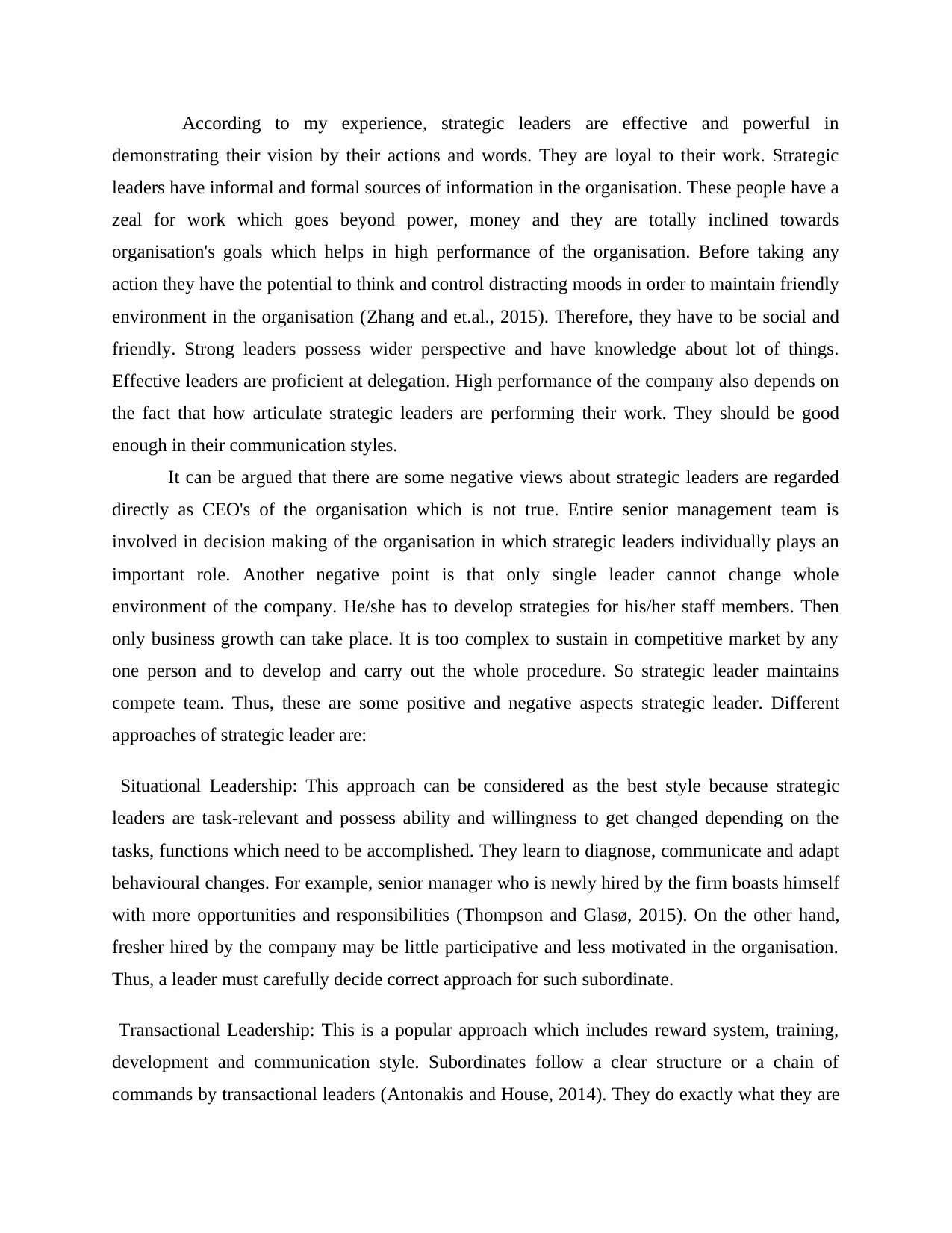
According to my experience, strategic leaders are effective and powerful in
demonstrating their vision by their actions and words. They are loyal to their work. Strategic
leaders have informal and formal sources of information in the organisation. These people have a
zeal for work which goes beyond power, money and they are totally inclined towards
organisation's goals which helps in high performance of the organisation. Before taking any
action they have the potential to think and control distracting moods in order to maintain friendly
environment in the organisation (Zhang and et.al., 2015). Therefore, they have to be social and
friendly. Strong leaders possess wider perspective and have knowledge about lot of things.
Effective leaders are proficient at delegation. High performance of the company also depends on
the fact that how articulate strategic leaders are performing their work. They should be good
enough in their communication styles.
It can be argued that there are some negative views about strategic leaders are regarded
directly as CEO's of the organisation which is not true. Entire senior management team is
involved in decision making of the organisation in which strategic leaders individually plays an
important role. Another negative point is that only single leader cannot change whole
environment of the company. He/she has to develop strategies for his/her staff members. Then
only business growth can take place. It is too complex to sustain in competitive market by any
one person and to develop and carry out the whole procedure. So strategic leader maintains
compete team. Thus, these are some positive and negative aspects strategic leader. Different
approaches of strategic leader are:
Situational Leadership: This approach can be considered as the best style because strategic
leaders are task-relevant and possess ability and willingness to get changed depending on the
tasks, functions which need to be accomplished. They learn to diagnose, communicate and adapt
behavioural changes. For example, senior manager who is newly hired by the firm boasts himself
with more opportunities and responsibilities (Thompson and Glasø, 2015). On the other hand,
fresher hired by the company may be little participative and less motivated in the organisation.
Thus, a leader must carefully decide correct approach for such subordinate.
Transactional Leadership: This is a popular approach which includes reward system, training,
development and communication style. Subordinates follow a clear structure or a chain of
commands by transactional leaders (Antonakis and House, 2014). They do exactly what they are
demonstrating their vision by their actions and words. They are loyal to their work. Strategic
leaders have informal and formal sources of information in the organisation. These people have a
zeal for work which goes beyond power, money and they are totally inclined towards
organisation's goals which helps in high performance of the organisation. Before taking any
action they have the potential to think and control distracting moods in order to maintain friendly
environment in the organisation (Zhang and et.al., 2015). Therefore, they have to be social and
friendly. Strong leaders possess wider perspective and have knowledge about lot of things.
Effective leaders are proficient at delegation. High performance of the company also depends on
the fact that how articulate strategic leaders are performing their work. They should be good
enough in their communication styles.
It can be argued that there are some negative views about strategic leaders are regarded
directly as CEO's of the organisation which is not true. Entire senior management team is
involved in decision making of the organisation in which strategic leaders individually plays an
important role. Another negative point is that only single leader cannot change whole
environment of the company. He/she has to develop strategies for his/her staff members. Then
only business growth can take place. It is too complex to sustain in competitive market by any
one person and to develop and carry out the whole procedure. So strategic leader maintains
compete team. Thus, these are some positive and negative aspects strategic leader. Different
approaches of strategic leader are:
Situational Leadership: This approach can be considered as the best style because strategic
leaders are task-relevant and possess ability and willingness to get changed depending on the
tasks, functions which need to be accomplished. They learn to diagnose, communicate and adapt
behavioural changes. For example, senior manager who is newly hired by the firm boasts himself
with more opportunities and responsibilities (Thompson and Glasø, 2015). On the other hand,
fresher hired by the company may be little participative and less motivated in the organisation.
Thus, a leader must carefully decide correct approach for such subordinate.
Transactional Leadership: This is a popular approach which includes reward system, training,
development and communication style. Subordinates follow a clear structure or a chain of
commands by transactional leaders (Antonakis and House, 2014). They do exactly what they are
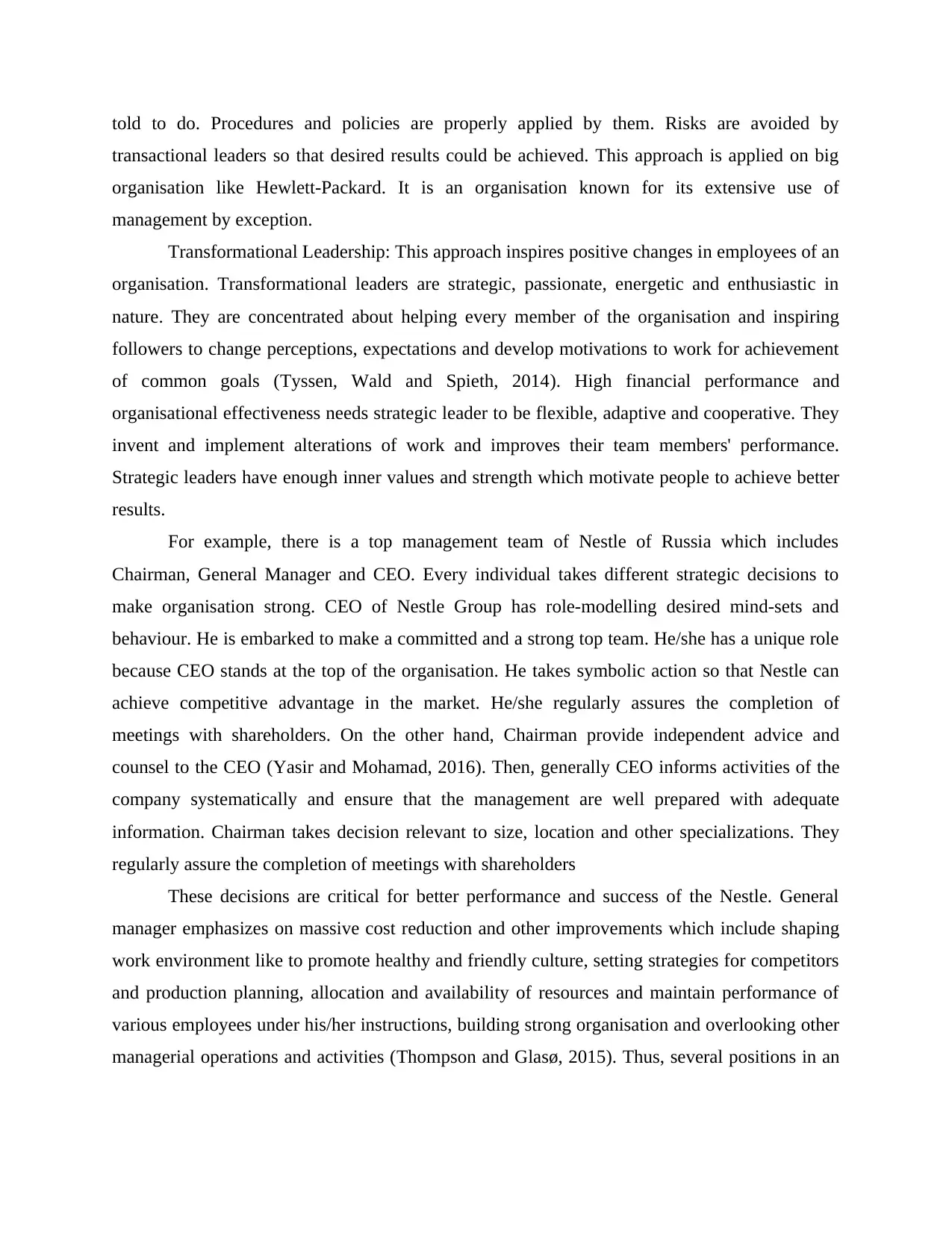
told to do. Procedures and policies are properly applied by them. Risks are avoided by
transactional leaders so that desired results could be achieved. This approach is applied on big
organisation like Hewlett-Packard. It is an organisation known for its extensive use of
management by exception.
Transformational Leadership: This approach inspires positive changes in employees of an
organisation. Transformational leaders are strategic, passionate, energetic and enthusiastic in
nature. They are concentrated about helping every member of the organisation and inspiring
followers to change perceptions, expectations and develop motivations to work for achievement
of common goals (Tyssen, Wald and Spieth, 2014). High financial performance and
organisational effectiveness needs strategic leader to be flexible, adaptive and cooperative. They
invent and implement alterations of work and improves their team members' performance.
Strategic leaders have enough inner values and strength which motivate people to achieve better
results.
For example, there is a top management team of Nestle of Russia which includes
Chairman, General Manager and CEO. Every individual takes different strategic decisions to
make organisation strong. CEO of Nestle Group has role-modelling desired mind-sets and
behaviour. He is embarked to make a committed and a strong top team. He/she has a unique role
because CEO stands at the top of the organisation. He takes symbolic action so that Nestle can
achieve competitive advantage in the market. He/she regularly assures the completion of
meetings with shareholders. On the other hand, Chairman provide independent advice and
counsel to the CEO (Yasir and Mohamad, 2016). Then, generally CEO informs activities of the
company systematically and ensure that the management are well prepared with adequate
information. Chairman takes decision relevant to size, location and other specializations. They
regularly assure the completion of meetings with shareholders
These decisions are critical for better performance and success of the Nestle. General
manager emphasizes on massive cost reduction and other improvements which include shaping
work environment like to promote healthy and friendly culture, setting strategies for competitors
and production planning, allocation and availability of resources and maintain performance of
various employees under his/her instructions, building strong organisation and overlooking other
managerial operations and activities (Thompson and Glasø, 2015). Thus, several positions in an
transactional leaders so that desired results could be achieved. This approach is applied on big
organisation like Hewlett-Packard. It is an organisation known for its extensive use of
management by exception.
Transformational Leadership: This approach inspires positive changes in employees of an
organisation. Transformational leaders are strategic, passionate, energetic and enthusiastic in
nature. They are concentrated about helping every member of the organisation and inspiring
followers to change perceptions, expectations and develop motivations to work for achievement
of common goals (Tyssen, Wald and Spieth, 2014). High financial performance and
organisational effectiveness needs strategic leader to be flexible, adaptive and cooperative. They
invent and implement alterations of work and improves their team members' performance.
Strategic leaders have enough inner values and strength which motivate people to achieve better
results.
For example, there is a top management team of Nestle of Russia which includes
Chairman, General Manager and CEO. Every individual takes different strategic decisions to
make organisation strong. CEO of Nestle Group has role-modelling desired mind-sets and
behaviour. He is embarked to make a committed and a strong top team. He/she has a unique role
because CEO stands at the top of the organisation. He takes symbolic action so that Nestle can
achieve competitive advantage in the market. He/she regularly assures the completion of
meetings with shareholders. On the other hand, Chairman provide independent advice and
counsel to the CEO (Yasir and Mohamad, 2016). Then, generally CEO informs activities of the
company systematically and ensure that the management are well prepared with adequate
information. Chairman takes decision relevant to size, location and other specializations. They
regularly assure the completion of meetings with shareholders
These decisions are critical for better performance and success of the Nestle. General
manager emphasizes on massive cost reduction and other improvements which include shaping
work environment like to promote healthy and friendly culture, setting strategies for competitors
and production planning, allocation and availability of resources and maintain performance of
various employees under his/her instructions, building strong organisation and overlooking other
managerial operations and activities (Thompson and Glasø, 2015). Thus, several positions in an
⊘ This is a preview!⊘
Do you want full access?
Subscribe today to unlock all pages.

Trusted by 1+ million students worldwide
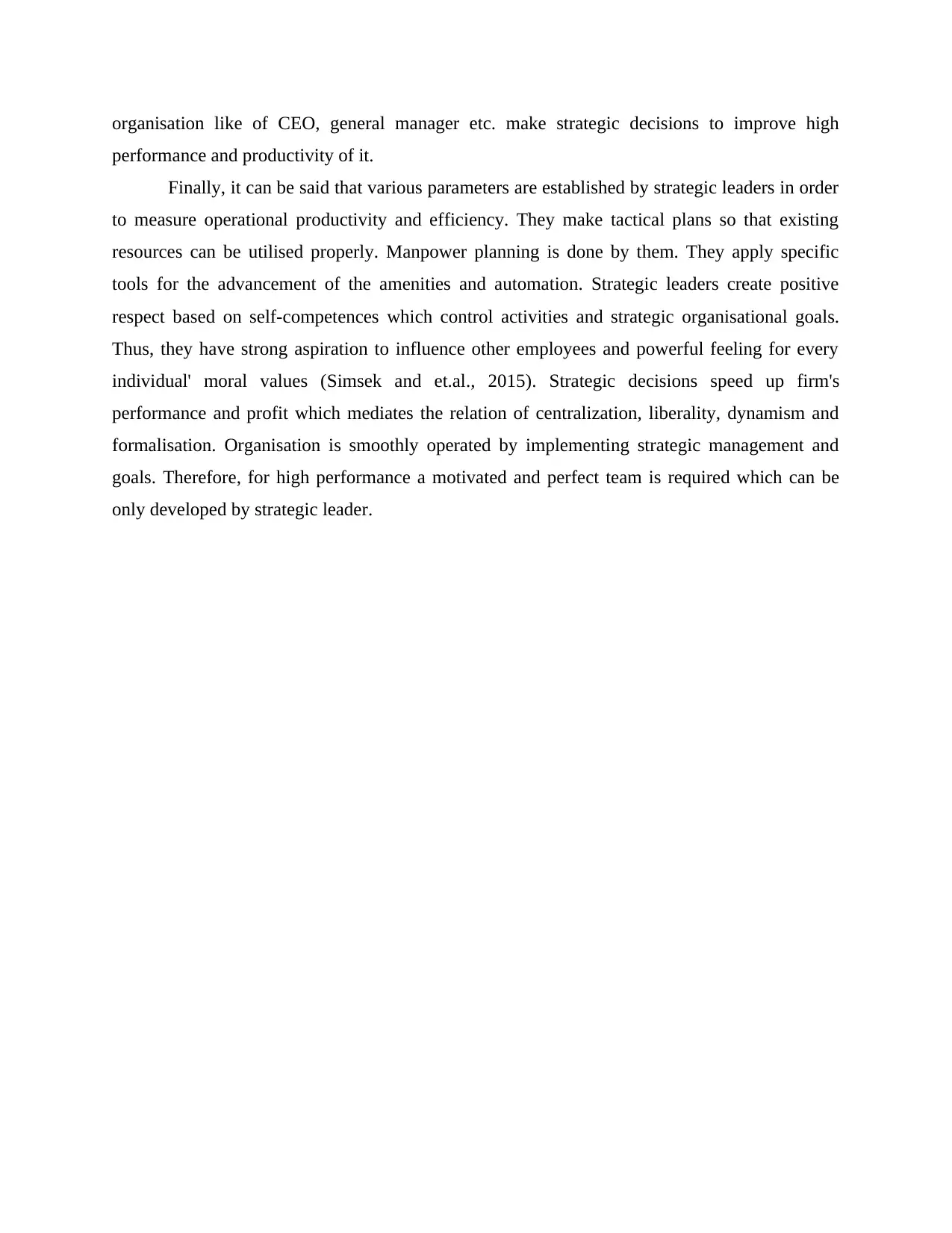
organisation like of CEO, general manager etc. make strategic decisions to improve high
performance and productivity of it.
Finally, it can be said that various parameters are established by strategic leaders in order
to measure operational productivity and efficiency. They make tactical plans so that existing
resources can be utilised properly. Manpower planning is done by them. They apply specific
tools for the advancement of the amenities and automation. Strategic leaders create positive
respect based on self-competences which control activities and strategic organisational goals.
Thus, they have strong aspiration to influence other employees and powerful feeling for every
individual' moral values (Simsek and et.al., 2015). Strategic decisions speed up firm's
performance and profit which mediates the relation of centralization, liberality, dynamism and
formalisation. Organisation is smoothly operated by implementing strategic management and
goals. Therefore, for high performance a motivated and perfect team is required which can be
only developed by strategic leader.
performance and productivity of it.
Finally, it can be said that various parameters are established by strategic leaders in order
to measure operational productivity and efficiency. They make tactical plans so that existing
resources can be utilised properly. Manpower planning is done by them. They apply specific
tools for the advancement of the amenities and automation. Strategic leaders create positive
respect based on self-competences which control activities and strategic organisational goals.
Thus, they have strong aspiration to influence other employees and powerful feeling for every
individual' moral values (Simsek and et.al., 2015). Strategic decisions speed up firm's
performance and profit which mediates the relation of centralization, liberality, dynamism and
formalisation. Organisation is smoothly operated by implementing strategic management and
goals. Therefore, for high performance a motivated and perfect team is required which can be
only developed by strategic leader.
Paraphrase This Document
Need a fresh take? Get an instant paraphrase of this document with our AI Paraphraser
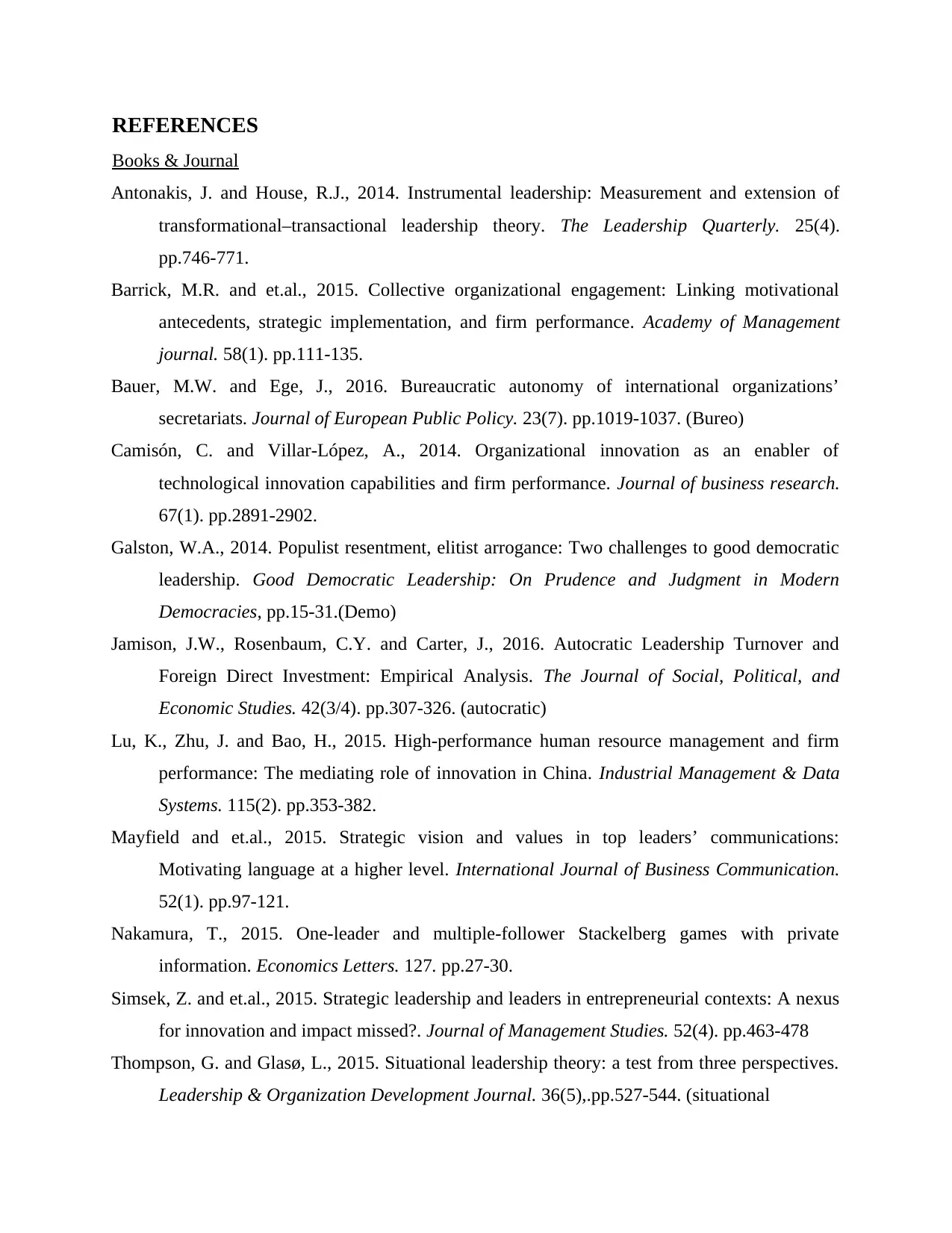
REFERENCES
Books & Journal
Antonakis, J. and House, R.J., 2014. Instrumental leadership: Measurement and extension of
transformational–transactional leadership theory. The Leadership Quarterly. 25(4).
pp.746-771.
Barrick, M.R. and et.al., 2015. Collective organizational engagement: Linking motivational
antecedents, strategic implementation, and firm performance. Academy of Management
journal. 58(1). pp.111-135.
Bauer, M.W. and Ege, J., 2016. Bureaucratic autonomy of international organizations’
secretariats. Journal of European Public Policy. 23(7). pp.1019-1037. (Bureo)
Camisón, C. and Villar-López, A., 2014. Organizational innovation as an enabler of
technological innovation capabilities and firm performance. Journal of business research.
67(1). pp.2891-2902.
Galston, W.A., 2014. Populist resentment, elitist arrogance: Two challenges to good democratic
leadership. Good Democratic Leadership: On Prudence and Judgment in Modern
Democracies, pp.15-31.(Demo)
Jamison, J.W., Rosenbaum, C.Y. and Carter, J., 2016. Autocratic Leadership Turnover and
Foreign Direct Investment: Empirical Analysis. The Journal of Social, Political, and
Economic Studies. 42(3/4). pp.307-326. (autocratic)
Lu, K., Zhu, J. and Bao, H., 2015. High-performance human resource management and firm
performance: The mediating role of innovation in China. Industrial Management & Data
Systems. 115(2). pp.353-382.
Mayfield and et.al., 2015. Strategic vision and values in top leaders’ communications:
Motivating language at a higher level. International Journal of Business Communication.
52(1). pp.97-121.
Nakamura, T., 2015. One-leader and multiple-follower Stackelberg games with private
information. Economics Letters. 127. pp.27-30.
Simsek, Z. and et.al., 2015. Strategic leadership and leaders in entrepreneurial contexts: A nexus
for innovation and impact missed?. Journal of Management Studies. 52(4). pp.463-478
Thompson, G. and Glasø, L., 2015. Situational leadership theory: a test from three perspectives.
Leadership & Organization Development Journal. 36(5),.pp.527-544. (situational
Books & Journal
Antonakis, J. and House, R.J., 2014. Instrumental leadership: Measurement and extension of
transformational–transactional leadership theory. The Leadership Quarterly. 25(4).
pp.746-771.
Barrick, M.R. and et.al., 2015. Collective organizational engagement: Linking motivational
antecedents, strategic implementation, and firm performance. Academy of Management
journal. 58(1). pp.111-135.
Bauer, M.W. and Ege, J., 2016. Bureaucratic autonomy of international organizations’
secretariats. Journal of European Public Policy. 23(7). pp.1019-1037. (Bureo)
Camisón, C. and Villar-López, A., 2014. Organizational innovation as an enabler of
technological innovation capabilities and firm performance. Journal of business research.
67(1). pp.2891-2902.
Galston, W.A., 2014. Populist resentment, elitist arrogance: Two challenges to good democratic
leadership. Good Democratic Leadership: On Prudence and Judgment in Modern
Democracies, pp.15-31.(Demo)
Jamison, J.W., Rosenbaum, C.Y. and Carter, J., 2016. Autocratic Leadership Turnover and
Foreign Direct Investment: Empirical Analysis. The Journal of Social, Political, and
Economic Studies. 42(3/4). pp.307-326. (autocratic)
Lu, K., Zhu, J. and Bao, H., 2015. High-performance human resource management and firm
performance: The mediating role of innovation in China. Industrial Management & Data
Systems. 115(2). pp.353-382.
Mayfield and et.al., 2015. Strategic vision and values in top leaders’ communications:
Motivating language at a higher level. International Journal of Business Communication.
52(1). pp.97-121.
Nakamura, T., 2015. One-leader and multiple-follower Stackelberg games with private
information. Economics Letters. 127. pp.27-30.
Simsek, Z. and et.al., 2015. Strategic leadership and leaders in entrepreneurial contexts: A nexus
for innovation and impact missed?. Journal of Management Studies. 52(4). pp.463-478
Thompson, G. and Glasø, L., 2015. Situational leadership theory: a test from three perspectives.
Leadership & Organization Development Journal. 36(5),.pp.527-544. (situational
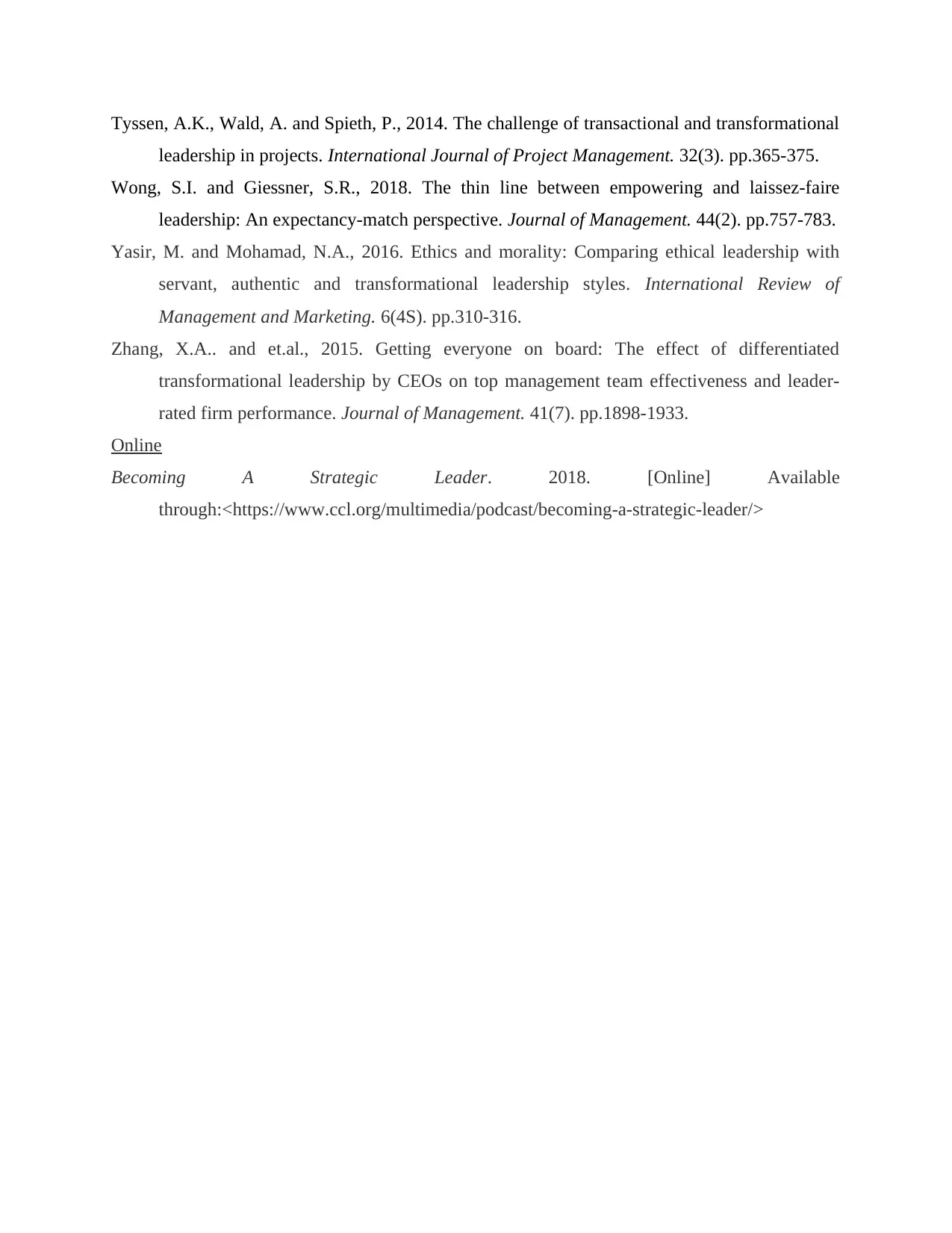
Tyssen, A.K., Wald, A. and Spieth, P., 2014. The challenge of transactional and transformational
leadership in projects. International Journal of Project Management. 32(3). pp.365-375.
Wong, S.I. and Giessner, S.R., 2018. The thin line between empowering and laissez-faire
leadership: An expectancy-match perspective. Journal of Management. 44(2). pp.757-783.
Yasir, M. and Mohamad, N.A., 2016. Ethics and morality: Comparing ethical leadership with
servant, authentic and transformational leadership styles. International Review of
Management and Marketing. 6(4S). pp.310-316.
Zhang, X.A.. and et.al., 2015. Getting everyone on board: The effect of differentiated
transformational leadership by CEOs on top management team effectiveness and leader-
rated firm performance. Journal of Management. 41(7). pp.1898-1933.
Online
Becoming A Strategic Leader. 2018. [Online] Available
through:<https://www.ccl.org/multimedia/podcast/becoming-a-strategic-leader/>
leadership in projects. International Journal of Project Management. 32(3). pp.365-375.
Wong, S.I. and Giessner, S.R., 2018. The thin line between empowering and laissez-faire
leadership: An expectancy-match perspective. Journal of Management. 44(2). pp.757-783.
Yasir, M. and Mohamad, N.A., 2016. Ethics and morality: Comparing ethical leadership with
servant, authentic and transformational leadership styles. International Review of
Management and Marketing. 6(4S). pp.310-316.
Zhang, X.A.. and et.al., 2015. Getting everyone on board: The effect of differentiated
transformational leadership by CEOs on top management team effectiveness and leader-
rated firm performance. Journal of Management. 41(7). pp.1898-1933.
Online
Becoming A Strategic Leader. 2018. [Online] Available
through:<https://www.ccl.org/multimedia/podcast/becoming-a-strategic-leader/>
⊘ This is a preview!⊘
Do you want full access?
Subscribe today to unlock all pages.

Trusted by 1+ million students worldwide
1 out of 9
Related Documents
Your All-in-One AI-Powered Toolkit for Academic Success.
+13062052269
info@desklib.com
Available 24*7 on WhatsApp / Email
![[object Object]](/_next/static/media/star-bottom.7253800d.svg)
Unlock your academic potential
Copyright © 2020–2025 A2Z Services. All Rights Reserved. Developed and managed by ZUCOL.





